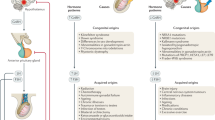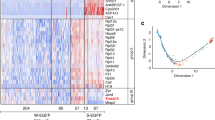Abstract
We have previously demonstrated that male transgenic (TG) mice overexpressing human chorionic gonadotropin (hCG+) develop reproductive organ defects, but no tumors, in adult age. In this study, the effects of persistently elevated hCG were followed in TG males between day 5 postpartum and adulthood. Leydig cell (LC) adenomas were found in prepubertal mice, most prominently at the age of 10 days, but not in adult age. Serum testosterone concentrations were significantly increased in TG males at all ages studied. The phenotype of the prepubertal hCG+ males resembled that found in boys upon expression of constitutively activating luteinizing hormone (LH) receptor mutations. The temporal expression patterns of the fetal LC marker gene, thrombospondin 2, and those of adult LCs, hydroxysteroid dehydrogenase-6, delta5-3-beta and prostaglandin D synthase, were similar in wild-type and hCG+ males. Hence, the postnatal adenomas resemble functionally fetal LCs, and only these cells are susceptible to hCG-induced tumorigenesis. Our findings demonstrate a novel intriguing difference between the fetal and adult LC populations and provide further insight into the potential tumorigenic effects of gonadotropins.
This is a preview of subscription content, access via your institution
Access options
Subscribe to this journal
Receive 50 print issues and online access
$259.00 per year
only $5.18 per issue
Buy this article
- Purchase on Springer Link
- Instant access to full article PDF
Prices may be subject to local taxes which are calculated during checkout







Similar content being viewed by others
References
Ariyaratne HB and Mendis-Handagama CS . (2000). Biol. Reprod., 62, 680–690.
Cattanach BM, Iddon CA, Charlton HM, Chiappa SA and Fink G . (1977). Nature, 269, 338–340.
Chemes HE . (1996). The Leydig Cell. Payne AH, Hardy MP and Russell LD (eds). Cache River Press: Vienna, pp. 175–202.
Christensen AK and Peacock KC . (1980). Biol. Reprod., 22, 383–391.
Clegg ED, Cook JC, Chapin RE, Foster PM and Daston GP . (1997). Reprod. Toxicol., 11, 107–121.
Cook JC, Klinefelter GR, Hardisty JF, Sharpe RM and Foster PM . (1999). Crit. Rev. Toxicol., 29, 169–261.
Habert R, Lejeune H and Saez JM . (2001). Mol. Cell. Endocrinol., 179, 47–74.
Hardy MP, Zirkin BR and Ewing LL . (1989). Endocrinology, 124, 762–770.
Hirakawa T, Galet C and Ascoli M . (2002). Endocrinology, 143, 1026–1035.
Huhtaniemi I, Nikula H and Rannikko S . (1985a). J. Clin. Endocrinol. Metab., 61, 698–704.
Huhtaniemi IT, Nozu K, Warren DW, Dufau ML and Catt KJ . (1982). Endocrinology, 111, 1711–1720.
Huhtaniemi IT, Warren DW and Catt KJ . (1985b). Biol. Reprod., 32, 721–732.
Huseby RA . (1980). Cancer Res., 40, 1006–1013.
Kananen K, Rilianawati, Paukku T, Markkula M, Rainio EM and Huhtanemi I . (1997). Endocrinology, 138, 3521–3531.
Kendall SK, Samuelson LC, Saunders TL, Wood RI and Camper SA . (1995). Genes Dev., 9, 2007–2019.
Keri RA, Lozada KL, Abdul-Karim FW, Nadeau JH and Nilson JH . (2000). Proc. Natl. Acad. Sci. USA, 97, 383–387.
Kerr JB and Knell CM . (1988). Development, 103, 535–544.
Korenbrot CC, Huhtaniemi IT and Weiner RI . (1977). Biol. Reprod., 17, 298–303.
Kumar TR, Wang Y and Matzuk MM . (1996). Endocrinology, 137, 4210–4216.
Kuopio T, Pelliniemi LJ and Huhtaniemi I . (1989). Biol. Reprod., 40, 135–143.
Li X, Nokkala E, Yan W, Streng T, Saarinen N, Warri A, Huhtaniemi I, Santti R, Makela S and Poutanen M . (2001). Endocrinology, 142, 2435–2442.
Liu G, Duranteau L, Carel JC, Monroe J, Doyle DA and Shenker A . (1999). N. Engl. J. Med., 341, 1731–1736.
Ma X, Dong Y, Matzuk MM and Kumar TR . (2004). Proc. Natl. Acad. Sci. USA, 101, 17294–17299.
Matzuk MM, DeMayo FJ, Hadsell LA and Kumar TR . (2003). Biol. Reprod., 69, 338–346.
Mikola M, Kero J, Nilson JH, Keri RA, Poutanen M and Huhtaniemi I . (2003). Oncogene, 22, 3269–3278.
Navickis RJ, Shimkin MB and Hsueh AJ . (1981). Cancer Res., 41, 1646–1651.
O'Shaughnessy PJ, Baker P, Sohnius U, Haavisto AM, Charlton HM and Huhtaniemi I . (1998). Endocrinology, 139, 1141–1146.
O'Shaughnessy PJ, Johnston H, Willerton L and Baker PJ . (2002a). J. Cell. Sci., 115, 3491–3496.
O'Shaughnessy PJ, Willerton L and Baker PJ . (2002b). Biol. Reprod., 66, 966–975.
Pakarinen P, Vihko KK, Voutilainen R and Huhtaniemi I . (1990). Endocrinology, 127, 2469–2474.
Parrott JA, Doraiswamy V, Kim G, Mosher R and Skinner MK . (2001). Mol. Cell. Endocrinol., 172, 213–222.
Prahalada S, Majka JA, Soper KA, Nett TM, Bagdon WJ, Peter CP, Burek JD, MacDonald JS and van Zwieten MJ . (1994). Fundam. Appl. Toxicol., 22, 211–219.
Richter-Unruh A, Wessels HT, Menken U, Bergmann M, Schmittmann-Ohters K, Schaper J, Tappeser S and Hauffa BP . (2002). J. Clin. Endocrinol. Metab., 87, 1052–1056.
Rulli SB, Ahtiainen P, Makela S, Toppari J, Poutanen M and Huhtaniemi I . (2003). Endocrinology, 144, 4980–4990.
Rulli SB, Kuorelahti A, Karaer O, Pelliniemi LJ, Poutanen M and Huhtaniemi I . (2002). Endocrinology, 143, 4084–4095.
Simon WE, Albrecht M, Hansel M, Dietel M and Holzel F . (1983). J. Natl. Cancer Inst., 70, 839–845.
Sundstrom J, Pelliniemi LJ, Kuopio T, Verajankorva E, Frojdman K, Harley V, Salminen E and Pollanen P . (1999). Br. J. Cancer, 80, 149–160.
Themmen APN and Huhtaniemi IT . (2000). Endocr. Rev., 21, 551–583.
Wise PM, Krajnak KM and Kashon ML . (1996). Science, 273, 67–70.
Zhang FP, Hamalainen T, Kaipia A, Pakarinen P and Huhtaniemi I . (1994). Endocrinology, 134, 2206–2213.
Zhang FP, Poutanen M, Wilbertz J and Huhtaniemi I . (2001). Mol. Endocrinol., 15, 172–183.
Acknowledgements
We thank Ms J Lahtinen and Ms T Laiho for their skilful technical assistance. This work was supported by grants from the Academy of Finland, The Finnish Cancer Society, the Sigrid Jusélius Foundation, the Turku Graduate School for Biomedical Sciences and the Wellcome Trust.
Author information
Authors and Affiliations
Corresponding author
Rights and permissions
About this article
Cite this article
Ahtiainen, P., Rulli, S., Shariatmadari, R. et al. Fetal but not adult Leydig cells are susceptible to adenoma formation in response to persistently high hCG level: a study on hCG overexpressing transgenic mice. Oncogene 24, 7301–7309 (2005). https://doi.org/10.1038/sj.onc.1208893
Received:
Revised:
Accepted:
Published:
Issue Date:
DOI: https://doi.org/10.1038/sj.onc.1208893
Keywords
This article is cited by
-
Human LH and hCG stimulate differently the early signalling pathways but result in equal testosterone synthesis in mouse Leydig cells in vitro
Reproductive Biology and Endocrinology (2017)
-
Animal models for aberrations of gonadotropin action
Reviews in Endocrine and Metabolic Disorders (2011)



